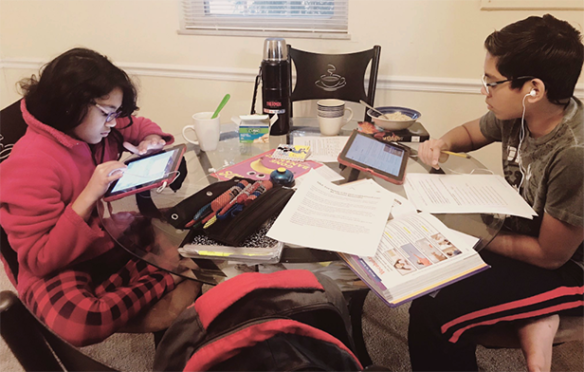
Fort Thomas Independent Superintendent Sharon Cheser shared this picture on her Twitter account from parent Nadeeka Abeysinghe about the first NTI day in the district, with her students hard at work.
Photo submitted
By Sky Carroll
sky.carroll@education.ky.gov
Kentucky school districts saw an average student participation rate of 92% in the first week of using non-traditional instruction (NTI) after school buildings were closed due to the COVID-19 pandemic, and an average of 91% in the last week that all 172 districts were using NTI.
Before the COVID-19 pandemic, 83 school districts were using the Kentucky Department of Education’s Non-Traditional Instruction (NTI) Program, which allows instruction to continue in the event of emergencies, such as a snow cancellation. By the end of the 2019-2020 school year, all 172 school districts had transitioned to using NTI, and have applied to use it again for the 2020-2021 school year because of the pandemic.
For in-person instruction, students are counted in attendance simply by being present at school. Since NTI occurs through a virtual platform, the attendance process had to change.
“We developed something called participation. It’s a way of measuring that a student is involved in the NTI process,” said David Cook, division director of the Kentucky Department of Education’s (KDE) Office of Continuous Improvement and Support.
He said that participation allows for a record of student and teacher interaction during NTI.
“Participation could be anything like a meeting through Google Meet or Zoom, a phone call or anything where students and teachers do something related to instruction,” Cook said.
Kentucky schools used more than 6,238 total days of NTI because of school building closures beginning in mid-March due to COVID-19. Each school kept track of daily student participation rates, which were submitted to KDE’s Office of Continuous Improvement and Support.
“For the most part, districts’ participation has been constant and those with existing NTI plans have found ways to keep kids engaged during the pandemic,” Cook said.
Kentucky’s largest district, Jefferson County, had not been approved to participate at NTI at the beginning of the 2019-2020 school year and had to develop an emergency NTI plan. The district saw a 96% participation rate in its first week of NTI. However, it had a 74% participation rate in its final week of NTI.
Fayette County, like quite a few districts, also saw a decline in participation rates over the last couple of weeks from 85% at the start to 58% in its final week of NTI. It’s important to note that Fayette County’s numbers were slightly lower overall because they were using new functionality in the Infinite Campus student information system that most districts didn’t utilize this spring. Their numbers may have been affected by being a new user of the system.
Cook said the gradual participation decline in some districts was expected because “no one anticipated so many days of NTI.”
For districts that had NTI plans prior to the COVID-19 pandemic, most saw steady rates of participation. Cook expects that most districts will see steadier rates for the upcoming school year since all districts now have experience with NTI.
Cook said the differing types of instruction and attendance that are expected to be used for the 2020-2021 school year may present a new set of challenges for districts. Some districts will have students learning both in-person and remotely, so Cook said schools will need to have lesson plans and assignments for both and record attendance or participation accordingly.
Cook said the definition of “participation” for NTI and remote learning won’t change for next year and KDE is finalizing plans for how to provide different learning options.



Leave A Comment